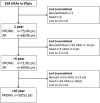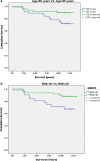Ten-year survival and patient-reported outcomes of a medial unicompartmental knee arthroplasty incorporating an all-polyethylene tibial component
- PMID: 29476323
- PMCID: PMC5904245
- DOI: 10.1007/s00402-018-2908-y
Ten-year survival and patient-reported outcomes of a medial unicompartmental knee arthroplasty incorporating an all-polyethylene tibial component
Abstract
Introduction: Biomechanical studies have suggested that proximal tibial strain is elevated in UKAs incorporating all-polyethylene tibial components with concern that this leads to premature failure. This study reports minimum 10-year outcomes for a UKA incorporating an all-polyethylene tibial component to determine whether these concerns were realised.
Materials and methods: 109 fixed bearing UKAs (97 patients, mean age 68 (range 48-87), 54/97 (56%) female) with all-polyethylene tibial components were followed up for ≥ 10 years with Oxford Knee Scores, Forgotten Joint Scores and Kaplan-Meier analysis. 106/109 implants were 7 mm, 3 were 9.5 mm.
Results: Ten-year survival was 85.5% (78.6-92.4 95% CI) with the end-point failure for any reason. Unexplained pain was the commonest mode of failure (6/17) followed by lateral compartment osteoarthritis (5/17) and tibial subsidence/loosening (4/17). Revision rate was highest at 2-5 years due to revisions for unexplained pain. Ten-year survival was worse in patients < 65 years old (p = 0.035), in those with BMI > 30 (p = 0.017) and in those with postoperative increases in medial tibial sclerosis (p < 0.001 log-rank). Implant malalignment was not significantly associated with failure. Radioisotope bone scans in 16 patients all remained "hot" at mean 6.1 years (range 2.1-11.5). Relative risk of failure in patients < 65 years was 2.9 (1.2-7.0 95% CI) and when BMI > 30 was 2.9 (1.2-6.9 95% CI). In those with intact UKAs at 10 years, mean Oxford Knee Score was 34.8 ± 10.7, Forgotten Joint Score was 37.9 ± 26.7 and 96% were satisfied with their knee.
Conclusion: The high rate of early failure between 2 and 5 years in this all-polyethylene tibial component UKA did not persist in the long term. Though medial proximal tibial metabolic changes appear to persist they are not necessarily symptomatic. BMI > 30 and age < 65 years were significant risk factors for revision.
Keywords: All-polyethylene tibia; Long-term survival; Unicompartmental knee arthroplasty.
Conflict of interest statement
All authors declare that they have no conflict of interest.
Figures





Similar articles
-
High Survival Rate and Very Low Wear of Lateral Unicompartmental Arthroplasty at Long Term: A Case Series of 54 Cases at a Mean Follow-Up of 17 Years.J Arthroplasty. 2019 Jun;34(6):1097-1104. doi: 10.1016/j.arth.2019.01.053. Epub 2019 Jan 29. J Arthroplasty. 2019. PMID: 30777626
-
Revision of Unicompartmental to Total Knee Arthroplasty: Does the Unicompartmental Implant (Metal-Backed vs All-Polyethylene) Impact the Total Knee Arthroplasty?J Arthroplasty. 2018 Jul;33(7):2203-2209. doi: 10.1016/j.arth.2018.02.003. Epub 2018 Feb 12. J Arthroplasty. 2018. PMID: 29525342
-
Cemented all polyethylene tibial insert unicompartimental knee arthroplasty: a long term follow-up study.Orthop Traumatol Surg Res. 2009 Feb;95(1):12-21. doi: 10.1016/j.otsr.2008.04.001. Epub 2009 Feb 4. Orthop Traumatol Surg Res. 2009. PMID: 19251232
-
Metal-Backed Tibial Components Do Not Reduce Risk of Early Aseptic Loosening in Unicompartmental Knee Arthroplasty: A Systematic Review and Meta-Analysis.J Knee Surg. 2020 Feb;33(2):180-189. doi: 10.1055/s-0038-1677506. Epub 2019 Jan 16. J Knee Surg. 2020. PMID: 30650439
-
A flat all-polyethylene tibial component in medial unicompartmental knee arthroplasty: a long-term study.Knee. 2014;21 Suppl 1:S20-5. doi: 10.1016/S0968-0160(14)50005-1. Knee. 2014. PMID: 25382363 Review.
Cited by
-
Obesity does not adversely impact the outcome of unicompartmental knee arthroplasty for osteoarthritis: a meta-analysis of 80,798 subjects.Int J Obes (Lond). 2021 Apr;45(4):715-724. doi: 10.1038/s41366-020-00718-w. Epub 2020 Nov 19. Int J Obes (Lond). 2021. PMID: 33214703
-
Metal-backed versus all-poly tibia in the original cartier unicompartmental knee arthroplasty: outcomes and survivorship at long-term follow-up.Arch Orthop Trauma Surg. 2024 Dec 27;145(1):95. doi: 10.1007/s00402-024-05741-4. Arch Orthop Trauma Surg. 2024. PMID: 39729090
-
Unicondylar knee replacement versus total knee replacement for the treatment of medial knee osteoarthritis: a systematic review and meta-analysis.Arch Orthop Trauma Surg. 2021 Aug;141(8):1361-1372. doi: 10.1007/s00402-021-03790-7. Epub 2021 Jan 29. Arch Orthop Trauma Surg. 2021. PMID: 33512583 Free PMC article.
-
Two-stage revision for periprosthetic joint infection in unicompartmental knee arthroplasty: clinical and radiological results.Arch Orthop Trauma Surg. 2022 Aug;142(8):2031-2038. doi: 10.1007/s00402-022-04464-8. Epub 2022 May 19. Arch Orthop Trauma Surg. 2022. PMID: 35589980 Free PMC article.
-
A rare case of oxidized zirconium - All polyethylene tibia unicompartmental arthroplasty failure: A case report.Int J Surg Case Rep. 2022 May;94:107042. doi: 10.1016/j.ijscr.2022.107042. Epub 2022 Apr 5. Int J Surg Case Rep. 2022. PMID: 35462143 Free PMC article.
References
-
- NJR (2014) NJR 11th Annual Report
-
- Australian (2012) Australian Orthopaedic Association: National Joint Replacement Registry Hip and Knee Arthroplasty Annual Report 2012
MeSH terms
Substances
LinkOut - more resources
Full Text Sources
Other Literature Sources
Medical

